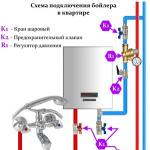
Non-standard methods solving quadratic equations
9th grade student
Head of work:
Firsova Daria Evgenevna
mathematic teacher

It is often more useful for a person studying algebra to solve the same problem in three different ways than to solve three or four problems. By solving one problem in different ways, you can find out by comparison which one is shorter and more efficient. This is how experience is developed.
U.U. Sawyer (20th century English mathematician)

Goal of the work
Study all existing ways to solve a quadratic equation. Learn to use these methods.
Tasks
- Understand what is called a quadratic equation.
- Find out what types of quadratic equations exist.
- Find information about ways to solve a quadratic equation and study it.

Relevance of the topic: People have been studying quadratic equations since ancient times. I wanted to know the history of the development of quadratic equations.
Not given in school textbooks full information about quadratic equations and methods for solving them.
An object: Quadratic equations.
Item: Methods for solving these equations.
Research methods: analytical.
Hypothesis – if, while researching this topic, I can realize the goals and objectives that I have set, then I will accordingly go on to implement pre-profile training in the field of mathematics education.

Research methods:
- Working with educational and popular science literature.
- Observation, comparison, analysis.
- Problem solving.
Expected results: In the course of studying this work, I will be able to really assess my intellectual potential and, accordingly, in the future, decide on a training profile, create a project product on the topic under study in the form of a computer presentation; studying this issue will allow me to compensate for the lack of knowledge on the designated topic.
I consider my work promising, since in the future this material can be used by both students to improve mathematical literacy and teachers in elective classes

Quadratic equations in Ancient Babylon
The need to solve equations not only of the first, but also of the second degree, back in ancient times, was caused by the need to solve problems related to finding the areas of land plots and earthworks military character, as well as with the development of astronomy and mathematics itself. The Babylonians were able to solve quadratic equations around 2000 BC. Using modern algebraic notation, we can say that in their cuneiform texts there are, in addition to incomplete ones, such, for example, complete quadratic equations:
The rule for solving these equations, set out in the Babylonian texts, coincides with the modern one, but it is not known how the Babylonians arrived at this rule. Almost all cuneiform texts found so far present only problems with solutions laid out in the form of recipes, with no indication as to how they were found. Despite high level development of algebra in Babylonia, the cuneiform texts lack the concept of a negative number and general methods for solving quadratic equations.

How Diophantus composed and solved
quadratic equations
THE EQUATION:
“Find two numbers knowing that their sum is 20 and their product is 96.”
Diophantus reasons as follows: from the conditions of the problem it follows that the required numbers Not are equal, because if they were equal, then their product would not be 96, but 100. Thus, one of them would be more than half of their sum, i.e. 10+X , the other is less, i.e. 10-X .
The difference between them is 2 X
From here X=2 . One of the required numbers is 12, the other is 8. Solution X = -2 for Diophantus does not exist, since Greek mathematics knew only positive numbers.
 0 One of the problems of the famous Indian mathematician of the 12th century Bhaskara A flock of frisky monkeys, having eaten to their hearts' content, had fun. Part eight of them in the square I was having fun in the clearing. And twelve on the vines... They began to jump while hanging... How many monkeys were there, tell me, in this flock? The equation corresponding to the problem: Baskara writes under the form: Completed the left side to a square," width="640"
0 One of the problems of the famous Indian mathematician of the 12th century Bhaskara A flock of frisky monkeys, having eaten to their hearts' content, had fun. Part eight of them in the square I was having fun in the clearing. And twelve on the vines... They began to jump while hanging... How many monkeys were there, tell me, in this flock? The equation corresponding to the problem: Baskara writes under the form: Completed the left side to a square," width="640" Quadratic Equations in India
Problems on quadratic equations are also found in the astronomical treatise “Aryabhattiam”, compiled in 499 by the Indian mathematician and astronomer Aryabhatta. Another Indian scientist, Brahmagupta, laid down a general rule for solving quadratic equations reduced to a single canonical form: ax ² +bx=c, a0
One of the problems of the famous Indian mathematician of the 12th century Bhaskara
A flock of frisky monkeys
Having eaten to my heart's content, I had fun.
Part eight of them squared
I was having fun in the clearing.
And twelve along the vines...
They started jumping while hanging...
How many monkeys were there?
Tell me, in this pack?
The equation corresponding to the problem is:
Baskara writes under the guise:
Completed the left side to a square,

Quadratic equations in Ancient Asia
X 2 +10 x = 39
This is how the Central Asian scientist al-Khwarizmi solved this equation:
He wrote: "The rule is:
double the number of roots, x=2x ·5
get five in this problem, 5
multiply by this equal to it, it becomes twenty-five, 5·5=25
add that to thirty-nine, 25+39
it will be sixty-four, 64
take the root from this, it becomes eight, 8
and subtract from this half the number of roots, i.e. five, 8-5
will remain 3
this will be the square root you were looking for."
What about the second root? The second root was not found, since negative numbers were not known.

Quadratic equations in Europe XIII-XVII centuries.
The general rule for solving quadratic equations reduced to a single canonical form x2+inx+c=0 was formulated in Europe only in 1544 Mr. Stiefel.
Formulas for solving quadratic equations in Europe were first set forth in 1202 by an Italian mathematician
Leonard Fibonacci.
The derivation of the formula for solving a quadratic equation in general form is available from Viète, but Viète recognized only positive roots. Only in the 17th century. thanks to the efforts Descartes, Newton and other scientists the method for solving quadratic equations takes modern look

About Vieta's theorem
The theorem expressing the relationship between the coefficients of a quadratic equation and its roots, named after Vieta, was first formulated by him in 1591 as follows: “If B + D times A-A equals BD, then A equals B and equals D.” .
To understand Vieta, one should remember that A, like any vowel letter, meant the unknown (our x), while the vowels B, D are coefficients for the unknown.
In the language of modern algebra, the above Vieta formulation means :
If the reduced quadratic equation x 2 +px+q=0 has real roots, then their sum is equal to -p, and the product is equal q, that is x 1 +x 2 = -p, x 1 x 2 = q
(the sum of the roots of the above quadratic equation is equal to the second coefficient taken with the opposite sign, and the product of the roots is equal to the free term).

- Factoring the Left Side of the Equation
- Vieta's theorem
- Applying properties of quadratic equation coefficients
- Solving quadratic equations using the method of “throwing” the leading coefficient
- Full square selection method
- Graphical method for solving quadratic equations
- Solving quadratic equations using compass and ruler
- Solving quadratic equations using a nomogram
- Geometric method for solving quadratic equations


Factorization method
bring a general quadratic equation to the form:
A(x)·B(x)=0,
where A(x) and B(x) are polynomials with respect to x.
Target:
Methods:
- Taking the common factor out of brackets;
- Using abbreviated multiplication formulas;
- Grouping method.
Example:
: X 2 + 10x – 24 = 0
Let's factorize the left side of the equation:
X 2 + 10x – 24 = x 2 + 12x – 2x – 24 = x(x + 12) – 2(x + 12) = = (x + 12)(x – 2);
(x + 12)(x – 2) = 0;
x + 12 = 0 or x – 2 = 0;
X 1 = -12 x 2 = 2 ;
The numbers – 12 and 2 are the roots of this equation.
Answer: x 1 = -12 ; X 2 = 2.

Solving equations using Vieta's theorem
x 1 And X 2 – roots of the equation
For example :
X 2 + 3X – 10 = 0
X 1 ·X 2 = – 10, which means the roots have different
signs
X 1 + X 2 = – 3, means larger in modulus
root - negative
By selection we find the roots: X 1 = – 5, X 2 = 2

Properties of coefficients of a quadratic equation
Let the quadratic equation ax be given 2 + bx + c = 0
If a + b + c = 0 (i.e. the sum of the coefficients
equation is zero), then X 1 = 1 , X 2 = c/a
If a - b + c = 0 , or b = a + c , That X 1 = – 1 , X 2 = – s/a .
Example :
137x 2 + 20x – 157 = 0.
a = 137, b = 20, c = -157.
a + b+ c = 137 + 20 – 157 =0.
x 1 = 1,
Answer: 1;
 0, by the theorem inverse to Vieta’s theorem, we obtain the roots: 5;6, then we return to the roots of the original equation: 2.5; 3." width="640"
0, by the theorem inverse to Vieta’s theorem, we obtain the roots: 5;6, then we return to the roots of the original equation: 2.5; 3." width="640" Solving equations using the "throw" method
Roots of quadratic equations ax 2 + bx + c = 0 And y 2 + by + ac = 0 related by the relation : x = y/a .
Consider the quadratic equation ax ² + bx + c = 0 , where a ≠ 0. Multiplying both sides by A , we get the equation а²х² + abх + ac = 0. Let ah = y , where X = y/a; then we come to the equation y² + bу + ac = 0 , equivalent to this one. Its roots at 1 And at 2 we find using Vieta's theorem. Finally we get X 1 = y 1 /a And X 2 = y 2 /a .
Solve the equation: 2x 2 - 11x +15 = 0.
Let's throw the coefficient 2 to the free term
at 2 - 11у +30= 0. D0, according to the theorem inverse to Vieta’s theorem, we obtain the roots: 5;6, then we return to the roots of the original equation: 2.5; 3.

Full square selection method
X 2 + 6x – 7 = 0
Select a complete square on the left side. To do this, we write the expression X 2 + 6x in the following form:
X 2 + 6x = x 2 + 2 x 3
In the resulting expression, the first term is the square of the number X, and the second is double the product X on 3 , so to get a complete square you need to add 3 2 , because
X 2 + 2 x 3 + 3 2 = (x + 3) 2
Let us now transform the left side of the equation X 2 + 6x – 7 = 0, adding and subtracting to it 3 2 , we have:
X 2 + 6x – 7 = x 2 + 2 x 3 + 3 2 – 3 2 – 7 =
= (x + 3) 2 – 9 – 7 = (x + 3) 2 – 16
Thus, this equation can be written as follows:
(x + 3) 2 –16 = 0 , i.e. (x + 3) 2 = 16 .
Hence, x + 3 - 4 = 0 or x + 3 + 4 = 0
X 1 = 1 X 2 = -7
Answer: -7; 1.

Graphical method for solving a quadratic equation
Without using formulas, a quadratic equation can be solved graphically
way. Let's solve the equation
To do this, we will build two graphs:
The abscissas of the intersection points of the graphs will be the roots of the equation.
If the graphs intersect at two points, then the equation has two roots.
If the graphs intersect at one point, then the equation has one root.
If the graphs do not intersect, then the equation has no roots.
Answer:

Solving quadratic equations using
compass and ruler
1. Select a coordinate system.
2. Let's plot the points S(-b/ 2 A; a+c/ 2 A) – the center of the circle and A( 0; 1 ) .
3. Let's draw a circle with radius S.A. .
Abscissas the points of intersection of the circle with the Ox axis are roots of this quadratic equation.
x 1
x 2

Solving quadratic equations using a nomogram
This is an old and undeservedly forgotten method of solving quadratic equations, placed on p. 83 “Four-digit mathematical tables” by V.M. Bradis.
For the equation
nomogram gives roots
Table XXII. Nomogram for solving the equation
This nomogram allows, without solving a quadratic equation, to determine the roots of the equation from its coefficients.

Geometric method for solving quadratic equations
An example that has become famous is from the “Algebra” of al-Khorezmi: X 2 + 10x = 39. In the original, this problem is formulated as follows: “The square and ten roots are equal to 39.”
S = x 2 + 10 x+ 25 (X 2 + 10 x = 39 )
S= 39 + 25 = 64 , whence it follows,
what is the side of the square ABCD ,
those. line segment AB = 8 .
x = 8 - 2,5 - 2,5 = 3

Based on the survey, it was found that:
- The following methods turned out to be the most difficult:
Factoring the left side of the equation,
Method for selecting a complete square.
- Rational methods of solution:
Solving quadratic equations using formula;
Solving equations using Vieta's theorem
- Has no practical application
Geometric method for solving quadratic equations.
- Never heard of these methods before:
Application of the properties of coefficients of a quadratic equation;
Using a nomogram;
Solving quadratic equations using compass and ruler;
The “transfer” method (this method aroused the interest of the students).

Conclusion
- these solution methods deserve attention, since they are not all reflected in school mathematics textbooks;
- mastering these techniques will help students save time and solve equations effectively;
- the need for a quick solution is due to the use of a test system for entrance exams;

THANK YOU BEHIND ATTENTION!
Municipal competition of research and creative works schoolchildren
"Step into Science"
MATHEMATICS section
Subject: Non-standard methods for solving irrational problems
equations.
Nuzhdina Maria, MAOU Secondary School No. 2
10th grade, Karymskoe village
Scientific supervisor: Vasilyeva Elena Valerievna,
mathematic teacher
MAOU secondary school No. 2, Karymskoe village
Karymskoe village, 2013
Abstract……………………………………………………………………………….3
Research plan……………………………………………………......4-5
Description of work:
§1. Basic techniques for solving irrational equations………………6-9
§2. Solving irrational equations by replacing the unknown…10-14
§3. Irrational equations reducible to modulus………….15-17
§4. Factorization…………………………………………...…..18-19
§5. Equations of the form………………………………………………………20-22
§6. Geometric mean theorem in irrational equations
; ……………………………23-24
4) List of references…………………………………………………….....25
Annotation.
Our theme research work: “Non-standard techniques for solving irrational equations.”
When performing the work it was necessary to: compare different solution methods; move from general methods to specific ones, and vice versa; argue and prove the assertions made; study and synthesize information collected from various sources. In this regard, the following research methods can be distinguished: empirical; logical and theoretical (research); step by step; reproductive and heuristic;
As a result of the work carried out, the following were obtained results and conclusions:
There are many techniques for solving irrational equations;
Not all irrational equations can be solved using standard techniques;
We have studied frequently occurring substitutions with the help of which complex irrational equations are reduced to the simplest ones;
We looked at non-standard techniques for solving irrational equations
Topic: “Non-standard techniques for solving irrational equations”
Nuzhdina M.P., Trans-Baikal Territory, Karymskoye village, MAOU Secondary School No. 2, 10th grade.
Research plan.
Object area The area in which we conducted our research is algebra. An object research- solving equations. Among the many equations, we considered irrational equations - item our research.
In a school algebra course, only standard methods and solutions are considered (raised to a power and simple techniques replacements). But during the research it became clear that there are irrational equations for which standard techniques and methods are not enough to solve. Such equations are solved using other, more rational methods.
Therefore, we believe that the study of such decision techniques is necessary and interesting job.
During the research, it became clear that there are a great many irrational equations and grouping them by types and methods is problematic.
Purpose research is the study and systematization of methods for solving irrational equations.
Hypothesis: If you know non-standard methods for solving irrational equations, this will improve the quality of performing some Olympiad and Unified State Exam test tasks.
To achieve the goals and test the hypothesis, it is necessary to solve the following tasks:
Describe the types of irrational equations.
Establish connections between types and methods of solution.
Assess the importance of checking and finding DL.
Consider non-standard cases when solving irrational equations (geometric mean theorem, properties of monotonicity of functions).
During the research process, many teaching aids such authors as M.I. Skanavi, I.F. Sharygina, O.Yu. Cherkasova, A.N. Rurukina, I.T. Borodulya, as well as articles from the scientific, theoretical and methodological journal “Mathematics at School”.
Topic: “Non-standard techniques for solving irrational equations”
Nuzhdina M.P., Trans-Baikal Territory, Karymskoye village, MAOU Secondary School No. 2, 10th grade.
Description of work.
§1 Basic techniques for solving irrational equations
The equation y(x)=0 is irrational if the function y(x) contains roots of an unknown quantity x or expressions depending on x.
Many irrational equations can be solved based only on the concepts of the root and the range of permissible values of the equation (ADV), but there are other methods, some of which will be discussed in the work.
The main technique for solving irrational equations is to isolate the radical in one part of the equation, then raise both parts of the equation to the appropriate power. If there are several such radicals, then the equation must be raised to its original power repeatedly; by the way, there is no need to care that the expression under the sign of the solitary radical is non-negative.
However, when raised to an even power, extraneous roots may appear, that is, roots that are not a solution to the original equation.
Therefore, when using such a decision method, the roots must be checked and extraneous ones discarded; in this case, verification is an element of the decision and is necessary even in cases where unnecessary roots did not appear, but the course of the decision was such that they could appear. On the other hand, sometimes it is easier to do a check than to prove that it is necessary.
Let's look at a few examples:
Answer: no roots
– extraneous root
In these examples, we looked at standard methods for solving irrational equations (raising both sides to a power and checking the roots).
However, many irrational equations can be solved by
based only on the concepts of the root and ODZ of the equation.
Since the equation includes only radicals of even degrees, it is enough to solve the system of inequalities.
3x -2x 2 +5 ≥0 (conditions of the ODZ equation)
4х 2 -26х +40 ≥0
Solving this system of inequalities we obtain:
x € Where x = 2.5.
x € (-∞; 2.5] ᴗ B)(0;1] G) is equal to:
A) -12 B) 12 C) -6 D) -9 E) 8
2. The sum of the modules of the roots of the equation - (√(5- x)√(5+x))+2=-1
is equal to:
A) 4 B) 8 C) 7 D) 5 E) 9
3. Roots of the equation x 4 =|(-|x|+1) 2 -1| belong to the set:
A)(-1;1) B) [-1;1] C)(4;11) D)(-1;0;1) D) (0;2]
4*.The value of a at which equation 2/ x= A- X has three roots, refers to the interval:
A) (3;+ ) B) [–1;12] V)(- ;1) D) )




